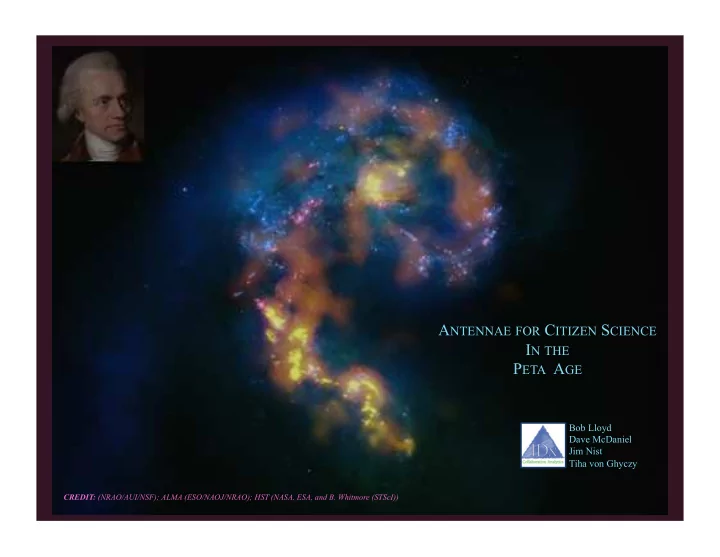

A NTENNAE FOR C ITIZEN S CIENCE I N THE P ETA A GE Bob Lloyd Dave McDaniel Jim Nist Tiha von Ghyczy CREDIT: (NRAO/AUI/NSF); ALMA (ESO/NAOJ/NRAO); HST (NASA, ESA, and B. Whitmore (STScI))
The Pulsar Search Collaboratory (PSC) partners the National Radio Astronomy Observatory with West Virginia University to provide students with opportunities to learn 21st Century Skills while conducting world class research in pulsar astronomy. PSC students join an international team of scientists analyzing more than 130 Terabytes of data collected by the Robert C. Byrd Green Bank Telescope for the purpose of discovering new pulsars!
“Citizen Science” (not crowd sourcing) A long but erratic history: A rich new lease on the future: Observation • De partibus animalium • BudBurst • the “amateurs” • HaSDEX • Longitude Prize Classification • Food Preservation Prize • Pulsar Search • • Planet Search OED • Galaxy Zoo • UK surveys flora/fauna Algorithms • one among pigeon breeders • GIMPS • NetFlix • “AlmaView” Optimization • FoldIt • “ ScopeTime ”
Galaxy Zoo Hanny’s voorwerp
Pea Galaxies Alongside its main pages allowing users to classify galaxies, GZ has an online forum. On this forum, users get to ask questions and post interesting images, ideas or unusual objects. In July 2007, a few days after the start of GZ, a thread was started by Hanny van Arkel called: Give peas a chance! …started humorously, soon it became clear that some of these unusual objects were a distinct group of galaxies. Enthusiasts , calling themselves the "Peas Corps", collected over a hundred of these Peas in a dedicated thread. The collection, once refined, provided values that could be used in a systematic computer search of the GZ database of one million objects. The search resulted in a sample of 251 Green Peas. Source: Wikipedia
Mon. Not. R. Astron. Soc. 000, 1 Printed 29 April 2011 Galaxy Zoo: Bar Lengths in Local Disk Galaxies ‡ Ben Hoyle, Karen. L. Masters, Robert C. Nichol, Edward M. Edmondson, Arfon M. Smith, Chris Lintott, Ryan Scranton, Steven Bamford, Kevin Schawinski, Daniel Thomas. ‡ This publication has been made possible by the participation of more than 200,000 volunteers in the Galaxy Zoo project.
3150 galaxies; “Zoo measurements” per galaxy: 3-10 Article addresses bias and robustness of this method in comparison to algorithmic estimates. More specically, this work would have been impossible without the help of the following GZ2 volunteers: [ca. 90-100 names follow] and 69 other volunteers.
“[ETHNO-]GENESIS OF GALAXY ZOO” Galaxy Zoo launched on July 11, 2007. BBC online article that same day. Cassifications coming in crashed Johns Hopkins U. hosting the site. Beefed up site: 20,000 classification per hour. Two days later: 60,000/hr. Less than one year later: 100,000 “zooites” had classified 900,000 galaxies 38 x. (About 1 galaxy day -1 zooite -1 ) Deluge of e-mails: internet forum. “Senior” zooites do most moderation. Blog for linking scientists to zooites. April 2009: forum has 11,000 members; blog attracts 25,000 unique visitors per month. Zooites off on highly eccentric orbits… GZ1 results were compared against three sets of independent galaxy classifications. In all cases, GZ1 classifications agree remarkably well. Conclusion was that using data from volunteers: • does not degrade quality of classification; • vastly accelerates pace of classification; • reduces scope for human error. L. FORTSON, K. MASTERS, R. NICHOL, K. BORNE, E. EDMONDSON, C. LINTOTT, J. RADDICK, K. SCHAWINSKI, J. WALLIN (arXiv 2011) – GALAXY ZOO: MORPHOLOGICAL CLASSIFICATION AND CITIZEN SCIENCE
Not the typical diffusive (sigmoidal) trajectory but explosive early growth combined with late steady increase… Big Bang + inflation + steady growth What about the bump(s)?
But why on a galaxy (or in a zoo)…? Galaxy Team H 0 Raddick e.a. study (2010) • beauty of the images; • desire to contribute to real scientific work. • good and lucky publicity. Extrinsic Intrinsic Theresa Amabile
“AlmaView” and the first two “almaites”
About IDx • Early stage company—founded 2010, based in Charlottesville. • Emphasis on Collaborative Analytics and a browser-based architecture. • Currently looking for lead partner with the following characteristics: • High-value, time-sensitive domains • Big Data (both structured and unstructured) • Benefit from a scalable platform that can be broadly disseminated.
Recommend
More recommend